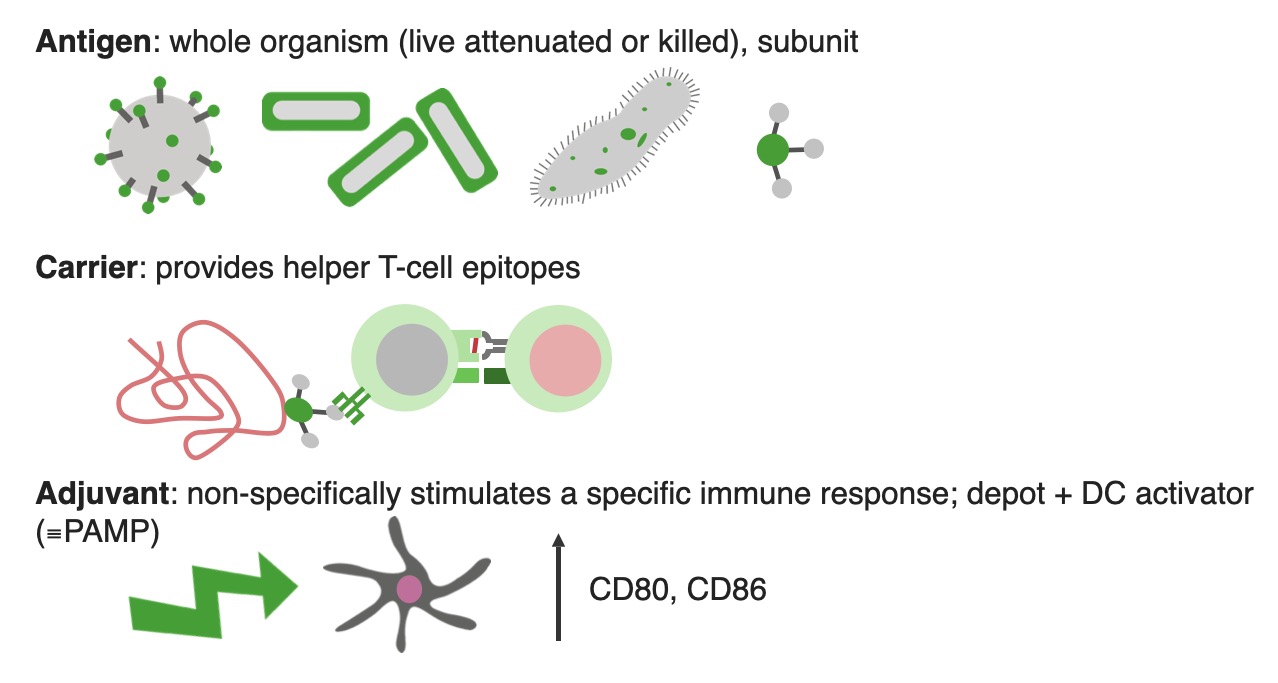Playlist
Show Playlist
Hide Playlist
Introduction to Vaccination
-
Slides Vaccine Immunology.pdf
-
Download Lecture Overview
00:01 If you’re wondering, what has immunology ever done for me? Well the answer’s quite simple -vaccination; a really easy procedure that protects all of us from infectious disease. 00:14 Vaccination is providing protection by utilizing either pre-existing components of the immune response or more commonly, by inducing the generation of antigen-specific memory cells. 00:28 We can divide immunization into active or passive immunization. 00:34 The most common form is active immunization where there is injection of antigen. 00:40 This often requires additional components, for example an adjuvant. 00:46 The immune response is generated in vivo. 00:50 It takes time to develop but it provides long term protection because there is generation of memory T-cells and memory B-cells in response to the vaccination. 01:02 There is the potential to develop both a cell-mediated and a humoral response. 01:09 In contrast, passive immunization is the injection of pre-formed antibodies. 01:16 This provides immediate protection, but the protection is short term. 01:22 Antibody has a half life of about three weeks in the circulation. 01:26 So the protection provided by these injected antibodies doesn’t last for a very long time. 01:34 It only provides humoral immunity. 01:37 The pathogen needs to be susceptible to antibody mediated destruction. 01:42 If cytotoxic T-cells are required, then passive immunization will not be helpful. 01:48 And there is the risk of adventitious pathogen transfer. 01:52 Let’s have a look at some examples of passive immunization. 01:57 Horse antisera against snake venom, botulism toxin and diphtheria toxin can be administered to individuals exposed to these toxic agents. 02:11 Pooled human immunoglobulin against Hepatitis A or B, measles, rabies, tetanus, varicella zoster, and humanized monoclonal antibody against respiratory syncytial virus can all be given to patients that are exposed to these agents. 02:36 With regard to active immunization, vaccines can induce neutralizing antibodies. 02:45 Viruses need to bind to cell surface receptors on cells in order to infect cells. 02:51 Antibodies can block the binding of viruses to their cell surface receptors. 02:58 Bacteria can produce toxins, these can poison our cells. 03:04 Antibodies can block the toxic activity of bacterial toxins. 03:11 Finally, in order to establish an infection, many microorganisms need to colonize surfaces in the body. 03:19 Antibodies, particularly dimeric secretory IgA can prevent colonization. 03:27 Let’s have a look at the immunological basis of active vaccination. 03:32 Here we have a diagram showing you the magnitude of the immune response following the first encounter with antigens from a pathogen. 03:41 This will be a natural infection that we would be exposed to. 03:45 The primary immune response is fairly weak and short lived. 03:52 However, if instead of encountering the natural infection, that is potentially pathogenic, we give a modified version of the pathogen; in other words the antigens are seen in a non-pathogenic form. 04:08 Then we elicit this primary immune response. 04:11 And importantly, memory T-cells and B-cells are generated. 04:18 Looking at the secondary immune response, if the subsequent encounter is with the actual pathogen itself, the individual goes straight into making a secondary immune response because the primary immune response was elicited by the non-pathogenic form. 04:38 And now there is a secondary immune response which is strong and long lasting. 04:45 And this occurs in response to the actual pathogen upon the first encounter. 04:52 So because memory cells are already present as a result of the vaccination, a secondary immune response occurs on the first encounter with the pathogen. 05:02 This is here really just for your information. 05:05 I’m not going to read through this. 05:06 You can read through it at your leisure. 05:09 But it provides you with the current vaccination schedule for the USA.
About the Lecture
The lecture Introduction to Vaccination by Peter Delves, PhD is from the course Vaccine Immunology.
Included Quiz Questions
In the childhood vaccination schedule in the USA, which of the following vaccines is generally given at birth?
- Hepatitis B vaccine
- Rotavirus vaccine
- Measles, mumps, rubella vaccine
- Influenza vaccine
- Inactive polio vaccine
Which of the following best describes active immunization?
- Slow response, long-term protection
- Immediate response, long-term protection
- Immediate response, short-term protection
- Slow response, short-term protection
Which of the following diseases requires annual or biannual preventive vaccination?
- Influenza
- Rabies
- Human papillomavirus
- Tetanus
- Varicella zoster infection
Passive immunization is available for which of the following infections?
- Hepatitis B
- Staphylococcus aureus
- Borrelia burgdorferii
- Chlamydia trachomatis
- Herpes simplex virus 1
Customer reviews
5,0 of 5 stars
| 5 Stars |
|
2 |
| 4 Stars |
|
0 |
| 3 Stars |
|
0 |
| 2 Stars |
|
0 |
| 1 Star |
|
0 |
Elegí la calificación máxima, por que la explicación esta bien estructurada.
Clearly explain new and important information. Distinctive style. A great summary of the topic




